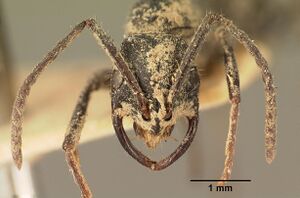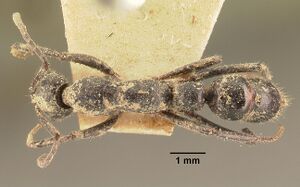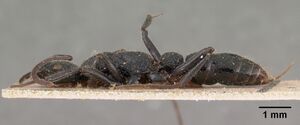Leptogenys incisa
| Leptogenys incisa | |
|---|---|

| |
| Scientific classification | |
| Kingdom: | Animalia |
| Phylum: | Arthropoda |
| Class: | Insecta |
| Order: | Hymenoptera |
| Family: | Formicidae |
| Subfamily: | Ponerinae |
| Tribe: | Ponerini |
| Genus: | Leptogenys |
| Species group: | incisa |
| Species complex: | alluaudi |
| Species: | L. incisa |
| Binomial name | |
| Leptogenys incisa Forel, 1891 | |
Only known from Madagascar, L. incisa is represented by one worker specimen collected from the transitional forest of Ambilanivy in the north-west peninsular area of Ampasindava and a few specimens from the Chains of Galoko Mountain. A few specimens were found foraging through leaf litter and others were found nesting in a rotten log.
Identification
A member of the alluaudi complex of the incisa species group. Rakotonirina and Fisher (2014) - Worker. Anteromedian border of clypeus, posterad of semi-translucent lamella without anteriorly projecting, small, peg-like setae. In full-face view, head distinctly elongate (CI: 85); eye breaking lateral cephalic margin; mandible strongly curved near the base, blades more or less broad, with slightly convex inner margin at about distal third, outer surfaces with dense and fine longitudinal striations; large species.
In addition to the strongly curved basal portion of its mandible, L. incisa has generally broader blades whose outer surfaces are finely, longitudinally striate. Its head is much more elongate than that of Leptogenys alluaudi and Leptogenys pilaka. In L. alluaudi and L. pilaka, the mandibles are not strongly curved near the bases, narrower and generally smooth besides piligerous punctures.
Keys including this Species
Distribution
Distribution based on Regional Taxon Lists
Afrotropical Region: Mozambique.
Malagasy Region: Madagascar (type locality).
Distribution based on AntMaps
Distribution based on AntWeb specimens
Check data from AntWeb
Countries Occupied
| Number of countries occupied by this species based on AntWiki Regional Taxon Lists. In general, fewer countries occupied indicates a narrower range, while more countries indicates a more widespread species. |

|
Estimated Abundance
| Relative abundance based on number of AntMaps records per species (this species within the purple bar). Fewer records (to the left) indicates a less abundant/encountered species while more records (to the right) indicates more abundant/encountered species. |

|
Biology
|
Castes
Images from AntWeb
    
| |
| Male (alate). Specimen code casent0101656. Photographer April Nobile, uploaded by California Academy of Sciences. | Owned by MHNG, Geneva, Switzerland. |
   
| |
| Worker. Specimen code casent0101723. Photographer April Nobile, uploaded by California Academy of Sciences. | Owned by MHNG, Geneva, Switzerland. |
   
| |
| Lectotype of Leptogenys imerinensis. Worker. Specimen code casent0101795. Photographer April Nobile, uploaded by California Academy of Sciences. | Owned by MHNG, Geneva, Switzerland. |
   
| |
| Paralectotype of Leptogenys imerinensis. Worker. Specimen code casent0101825. Photographer April Nobile, uploaded by California Academy of Sciences. | Owned by MHNG, Geneva, Switzerland. |
    
| |
| Lectotype of Leptogenys suarensis. Worker. Specimen code casent0102014. Photographer April Nobile, uploaded by California Academy of Sciences. | Owned by MSNG, Genoa, Italy. |
   
| |
| Worker. Specimen code casent0102414. Photographer April Nobile, uploaded by California Academy of Sciences. | Owned by NHMUK, London, UK. |
Nomenclature
The following information is derived from Barry Bolton's Online Catalogue of the Ants of the World.
- incisa. Leptogenys incisa Forel, 1891b: 113, pl. 4, fig. 1 (w.) MADAGASCAR.
Unless otherwise noted the text for the remainder of this section is reported from the publication that includes the original description.
Description
Worker
Rakotonirina and Fisher (2014) - (1 specimen). HW: 1.87, HL: 2.19, CI: 85, SL: 2.67, SI: 143, PW: 1.42, WL: 3.83, PNH: 1.26, PNL: 1.18, PNW: 1.13, DNI: 96, LNI: 107.
Head elongate and distinctly increasing in width from rear to front; lateral margin weakly convex along their length. Eye large, protruding from surface of head and breaking lateral cephalic border. Antennal scape relatively long (SI: 143). Clypeus with a narrowly triangular anteromedial margin; lateral margin slightly convex and strongly converging anteriorly, bordered with narrow lamella which becomes obtusely angulate on the anterior clypeal margin. Mandible long and strongly curved near the base; inner margin broadly convex at about distal third; basal groove impressed. Hypostomal teeth not visible when head in full-face view. In lateral view, mesosoma short and high; propodeal dorsum forming distinct angle with declivity; posterolateral margin of propodeum at about the level of propodeal spiracle with toothlike lobe. With mesosoma in dorsal view, metanotal groove impressed; metanotal sclerite indistinct. Visible constriction present between third and fourth abdominal segments. Mandible densely and finely striate, with sparse, small punctures. Head dorsum with longitudinal rugulae in front at the level of anterior margin of eyes and with dense, transverse reticulate-rugulae behind the level of eyes; large, shallow punctures present on the effaced rough sculpture near the occiput. Pronotum finely microreticulate, superimposed with coarse punctures. Rest of mesosoma, dorsum and petiolar node coarsely and transversely rugose. Propodeal declivity with transverse rugae. Third abdominal tergite covered with small and quite sparse punctures. Standing hairs long and slender, with reduced pubescence on mesosoma, petiolar node and gaster. Integument black, with dark brown appendages and light brown tarsal segments and apex of gaster.
Type Material
Rakotonirina and Fisher (2014) - Syntype workers, Madagascar, Montagne de Lokobe, Nosy-be (O’Swald) (location of types unknown).
References
- Bolton, B. 1975a. A revision of the ant genus Leptogenys Roger (Hymenoptera: Formicidae) in the Ethiopian region with a review of the Malagasy species. Bull. Br. Mus. (Nat. Hist.) Entomol. 31: 235-305.
- Forel, A. 1891c. Les Formicides. [part]. In: Grandidier, A. Histoire physique, naturelle, et politique de Madagascar. Volume XX. Histoire naturelle des Hyménoptères. Deuxième partie (28e fascicule). Paris: Hachette et Cie, v + 237 pp. (page 113, pl. 4, fig. 1 worker described)
- Rakotonirina, J.C. & Fisher, B.L. 2014. Revision of the Malagasy ponerine ants of the genus Leptogenys Roger (Hymenoptera: Formicidae). Zootaxa 3836, 1-163.
References based on Global Ant Biodiversity Informatics
- Bolton B. 1975. A revision of the ant genus Leptogenys Roger (Hymenoptera: Formicidae) in the Ethiopian region with a review of the Malagasy species. Bulletin of the British Museum (Natural History). Entomology 31: 235-305.
- Emery C. 1911. Hymenoptera. Fam. Formicidae. Subfam. Ponerinae. Genera Insectorum 118: 1-125.
- Fisher B. L. 1997. Biogeography and ecology of the ant fauna of Madagascar (Hymenoptera: Formicidae). Journal of Natural History 31: 269-302.
- Fisher B. L. 2003. Formicidae, ants. Pp. 811-819 in: Goodman, S. M.; Benstead, J. P. (eds.) 2003. The natural history of Madagascar. Chicago: University of Chicago Press, xxi + 1709 pp.
- Rakotonirina J. C., and B. L. Fisher. 2014. Revision of the Malagasy ponerine ants of the genus Leptogenys Roger (Hymenoptera: Formicidae). Zootaxa 3836 (1): 001163.
- Wheeler W. M. 1922. Ants of the American Museum Congo expedition. A contribution to the myrmecology of Africa. IX. A synonymic list of the ants of the Malagasy region. Bulletin of the American Museum of Natural History 45: 1005-1055

